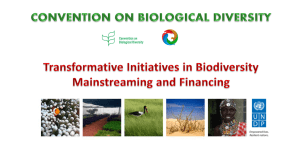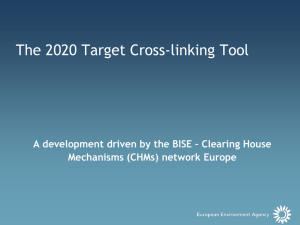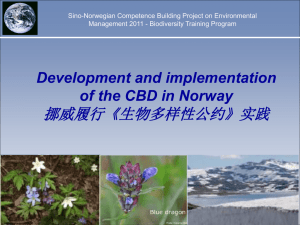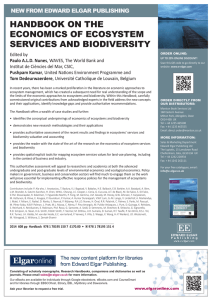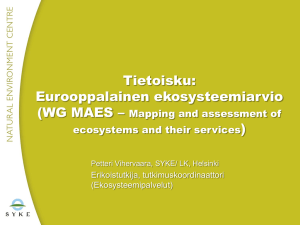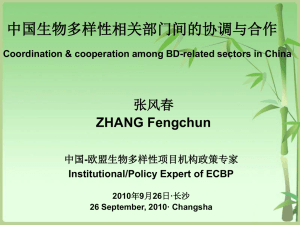Peer Review Framework
advertisement
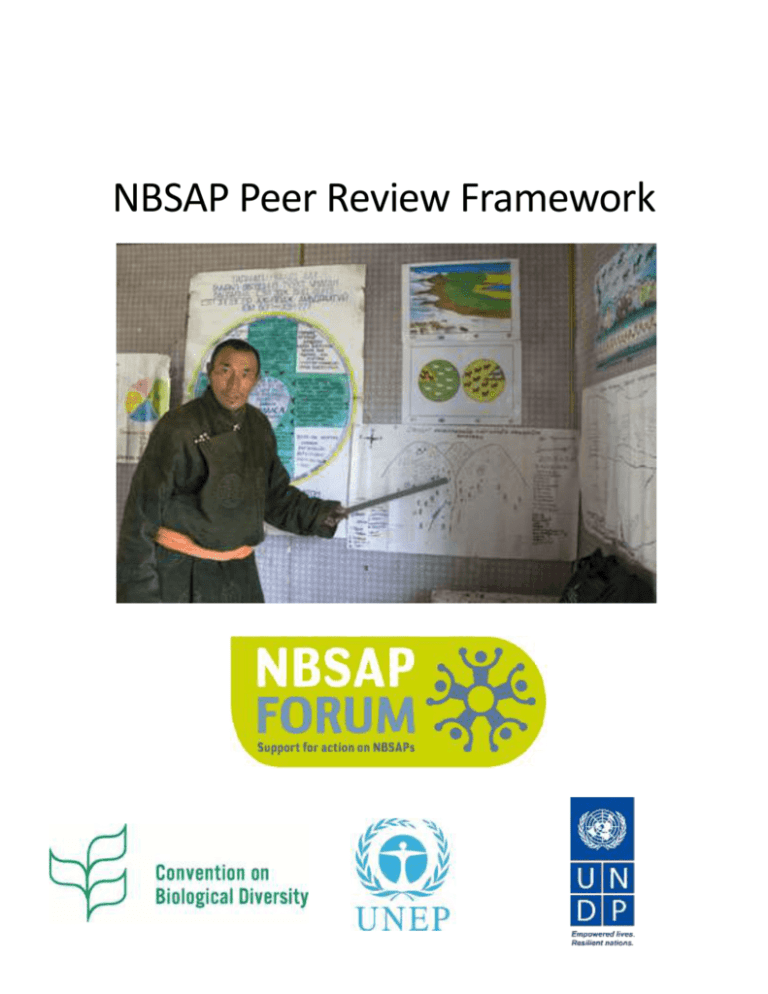
NBSAP Peer Review Framework www.nbsapforum.net NBSAP Peer Review Framework The purpose of this document is to enable teams who have revised their NBSAP, and to enable peer reviewers of newly revised NBSAPs, to ensure that the new NBSAP meets global best practices. This framework has been written to encourage the revision of NBSAPs that are in alignment with guidance in Decision IX/8 of the Conference of Parties as well as with the Aichi Biodiversity Targets. For questions, or for further information, please contact admin@nbsapforum.net. Please also visit www.nbsapforum.net for more detailed guidance on revising NBSAPs. SECTION 1: THE NBSAP REVISION PROCESS This section describes elements that may or may not be described in the NBSAP itself, but may be described in other supporting documentation Clearly Partially Not NBSAP REVISION PROCESS REFLECTIONS, evident evident evident OBSERVATIONS, RECOMMENDATIONS 1. Lessons from the previous NBSAP, and NBSAP development process, are clearly identified and integrated into the revision process. 2. The NBSAP revision committee includes representatives of key stakeholder and rights-holders groups pertaining to biodiversityrelated issues in the country. 3. Key stakeholders and their interests have been clearly identified in the revision process. 4. There is a fair, inclusive and transparent process for engaging with key stakeholder groups in the revision process, with an emphasis on vulnerable groups, including rural communities, women, and indigenous communities. 5. There is a mechanism for identifying and fairly and transparently resolving disputes related to the NBSAP revision process. 6. There is a comprehensive, clearly defined communication and outreach plan regarding the NBSAP revision process. 7. There is an effective data management system in place that allows for ongoing monitoring and analysis for NBSAP-related data. SECTION 2: KEY BACKGROUND INFORMATION Note that the following elements may or may not be in the NBSAP itself (e.g., may be in the 5 th National Report or other documents) but the results of the analyses should clearly be referenced in the NBSAP Clearly Partially Not Relevant STATUS AND TRENDS: The revised NBSAP clearly references REFLECTIONS, evident evident evident the results of analyses regarding the current status and trends Aichi OBSERVATIONS, Targets over time for the following: RECOMMENDATIONS 8. The extent and spatial distribution of area under sustainable 4, 6, 7 forestry, fisheries, grazing, agriculture and water management, including information on safe ecological limits of these productive systems, is identified. 9. The extent and spatial distribution of areas where extractive and economic sectors are engaged in sustainable production, processing and manufacturing practices, including waste management, energy, tourism, mining, transportation, manufacturing is identified. 10. The degree to which national consumption of resources, and the production of key commodities, harms biodiversity and falls beyond safe ecological limits is identified. 11. The rate of loss of natural habitats, including forests, is identified and spatially mapped. 12. The area and distribution within land use plans of areas targeted for intensive economic growth, for sustainable use and for conservation of biodiversity, is identified and mapped. 13. The source, extent, spatial distribution, severity, impact and trends of key pressures and threats, including invasive species, climate change and pollution, among other pressures, are identified and mapped. 14. Key species and ecosystems, including changes in spatial distribution, ecological integrity, extinction risks, protection status and key threats are identified and mapped. 15. Changes in the ecological integrity, threats and protection status of key ecosystems vulnerable to climate change impacts, including coral reefs, coastal areas, grasslands, and montane areas, among others are identified and mapped. 16. Key biodiversity areas (e.g., important bird areas, zero extinction areas), including changes in extent, ecological integrity, protection status and key threats are identified and mapped. 17. The extent, spatial distribution, governance types and categories, and representativeness of protected areas is identified and mapped, including for terrestrial, freshwater and marine areas, and other conserved areas. 18. Protected area management effectiveness, including for a range of protected area governance types and categories has been assessed. 19. Key connectivity areas (including corridors, buffers, stepping stones), and changes in their extent, ecological integrity, protection status and threats are identified and mapped. 20. Ecosystems providing essential ecosystem services, such as water, food, livelihoods, disaster risk reduction, and the extent of their ecological integrity, threat and protection, are identified and mapped 21. Changes in the stocks and flows of essential ecosystem services are identified, and opportunities for integrating these into national accounting, national plans and national decisionmaking frameworks. 22. The distribution, conservation, and sustainable use of genetic diversity, including of cultivated plants, farmed and domesticated animals, and wild crop relatives is identified and mapped, and opportunities for incorporating these into protected area and sustainable use plans are identified. 4 4 5 2, 5, 11 5, 6, 8, 9 5, 11, 12 6, 10, 11 5, 11, 12 11 11 11, 12 9, 11, 14, 15 2, 14 6, 7, 11, 13 Clearly evident Clearly evident Partially evident Partially evident Not evident Not evident POLICY, INSTITUTIONAL AND FINANCIAL ANALYSES: The revised NBSAP clearly references the results of analyses regarding: 23. The opportunities and timeframes for linking the NBSAP and its components to existing planning processes in the environmental and other sectors (such as poverty reduction, national development, sustainable development, land use, agricultural development, forestry, water, coastal management, climate change, disaster risk reduction) are clearly identified. 24. The extent to which key drivers of biodiversity change and their underlying causes, including an analysis of the impacts of key sectoral practices and policies on biodiversity and ecosystems, are identified and mapped. 25. The extent to which the economic value of key ecosystem services, including their contribution to national sustainable development goals has been assessed, and opportunities for integrating these into national plans, national accounting, sustainable resource use plans and protection plans. 26. The extent to which key laws, policies, subsidies and incentives that facilitate and/or inhibit sustainable use, conservation and equitable benefits sharing are assessed. 27. The extent to which key institutions, institutional structures and institutional capacities that facilitate and/or inhibit sustainable use, conservation and equitable benefits sharing have been identified and assessed. 28. The degree to which national expenditures on biodiversityrelated actions, including by public and private actors and environmentally positive and harmful incentives, have been assessed. 29. The extent of awareness of key constituencies of the multiple values of biodiversity, ecosystems and ecosystem services to local and national economies, to communities and to national sustainable development goals, has been assessed. Relevant Aichi Targets 2, 3, 4 2, 3, 4 2, 4, 19 3, 7, 16 4, 6, 7 19, 16 3, 20 1, 2, 19 SECTION 3: NBSAP ELEMENTS This section includes elements that are typically found within an NBSAP Relevant BACKGROUND, SUMMARY AND INTRODUCTION Aichi Targets 30. The NBSAP includes a clearly articulated national vision, including key principles and goals for biodiversity; and a description of linkages with national sustainable development, with the principles of the Rio Declaration and key CBD approaches, such as the ecosystem approach, gender-based approach and pro-poor approach, are clearly articulated. 31. The NBSAP includes a set of SMART national targets and indicators, clearly linked to Aichi Biodiversity Targets and to NBSAP strategies and actions. 32. The NBSAP includes a summary of key NBSAP strategies for policy makers and decision makers, highlighting key results, findings, strategies and priorities has been developed. 33. The NBSAP includes a summary of the process for revising the NBSAP, including major actors, timelines, stakeholders and committee members. 34. The NBSAP includes a summary of key lessons learned from the previous NBSAP, including an identification of key gaps, and an analysis of lessons learned in implementing the NBSAP. REFLECTIONS, OBSERVATIONS, RECOMMENDATIONS 2 17 17 17 17 REFLECTIONS, OBSERVATIONS, RECOMMENDATIONS Clearly evident Partially evident Not evident STRATEGIES AND ACTIONS: A clear set of strategies, actions, targets and indicators, consistent with national conditions, for each of the following: Relevant Aichi Targets Strategies to address the underlying causes of biodiversity loss 2 35. There are strategies and actions for integrating the values of biodiversity into national accounting procedures. 36. There are strategies and actions for eliminating, phasing out or reforming harmful subsidies and incentives; and for creating positive incentives. 37. There are strategies and actions for significantly reducing the consumption of products that are harmful to biodiversity, including through sustainable harvest, production, distribution and/or consumption. 3 4 Strategies to reduce direct pressures and promote sustainable use 3, 4 38. There are strategies and actions for significantly reducing the extent and percentage of unsustainable sectoral practices, including waste management, energy, tourism, mining, transportation, manufacturing. 39. There are strategies and actions for increasing the area and percentage of agriculture, forestry, grasslands, aquaculture and fisheries under sustainable management and managed within safe ecological limits. 40. There are strategies and actions for ensuring pollution, including from excess nutrients, has been brought to levels that are not detrimental to ecosystem function and biodiversity, especially for coastal and marine ecosystems. 41. There are strategies and actions for identifying and prioritizing pathways for invasive alien species, and control, eradicate or prevent their introduction and establishment. 42. There are strategies and actions for strengthening land use planning and spatial planning to identify specific areas for economic growth, and for sustainable use and conservation of biodiversity, and to account for essential ecosystems. 6, 7 8, 10 8 2, 5, 7, 8, 14 Strategies to safeguard ecosystems, species and genetic diversity 5, 11 43. There are strategies and actions for significantly reducing the rate of loss of all natural habitats, including forests. 44. There are strategies and actions for increasing the extent and improving the ecological functioning and representativeness of the protected area network, including terrestrial, freshwater and marine protected areas, and other conserved areas 45. There are strategies and actions for diversifying the governance types and categories of protected areas, including through the establishment of community conserved areas, private reserves, locally managed marine areas and other types of conserved areas 46. There are strategies and actions for strengthening protected area management effectiveness and capacity, including both the ability to manage against multiple threats and to manage for multiple benefits, for all types and categories of protected areas. 47. There are strategies and actions for preventing extinctions, and improving the conservation status of key species, including those species vulnerable to climate change impacts. 11 11 11 11, 12, 15 Strategies to enhance the benefits to all from biodiversity and ecosystem services 48. There are strategies and actions for strengthening the 10, 15 resilience of vulnerable ecosystems to climate change impacts, including coral reefs, grasslands, coastal areas, montane areas, among others through restoration and other means REFLECTIONS, OBSERVATIONS, COMMENTS OR RECOMMENDATIONS 49. There are strategies and actions for creasing connectivity at a landscape/seascape scale, including through ecological corridors, buffers, stepping stones. 50. There are strategies and actions for restoring and safeguarding key ecosystems that provide key ecosystem services, particularly food security, water security, carbon sequestration, livelihoods and disaster risk reduction. 51. There are strategies and actions for ensuring fair and equitable sharing of benefits arising from the utilization of biodiversity, including genetic resources. 11, 14, 15 5, 11, 14, 15 13, 16 Strategies for enabling and enhancing implementation 52. There are strategies and actions for integrating traditional knowledge, innovations and practices of indigenous and local communities into implementation of the NBSAP and ensuring effective participation. 53. There are strategies and actions for communicating the values, functioning, status and trends of biodiversity and the consequences of its loss. 18 1, 19 SECTION 4: IMPLEMENTATION AND RESOURCE MOBILIZATION PLAN This section identifies components that may not be in the NBSAP itself, but that are an essential component for effective implementation Clearly Partially Not Relevant Implementation and resource mobilization plan REFLECTIONS, evident evident evident Aichi OBSERVATIONS, Targets RECOMMENDATIONS 54. There is a comprehensive, well-organized implementation plan 17 that identifies priorities, actors, responsibilities and timelines for each strategy; and support for both national and local actions. 55. There is a plan for strengthening the capacities required to 17 implement the NBSAP. 56. There is a clear, realistic costing associated with each strategy 20 within the NBSAP, including key assumptions, unit costs, and estimated cost ranges. 57. There is a plan for mobilizing resources, including an analysis 20 of key financial actors, opportunities and mechanisms for each strategy. 58. There is a communication and outreach plan for 1, 19 communicating key findings, lessons, results and progress from the NBSAP to a variety of constituencies. 59. There is a plan for monitoring progress on implementation and 17, 19 adapting priorities based on lessons learned in implementation, and a plan to scientific and technical cooperation, within an appropriate national institutional arrangement. 60. There is a plan for integrating key strategies into national 2 budgeting, sustainable development, sectoral, land use and other planning and policy frameworks. Cover photo: Eskinder Debebe, © UN 2009

